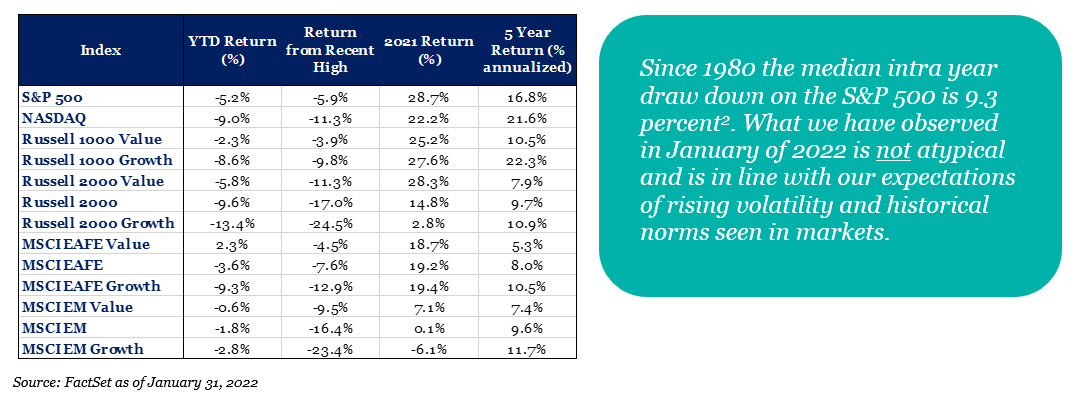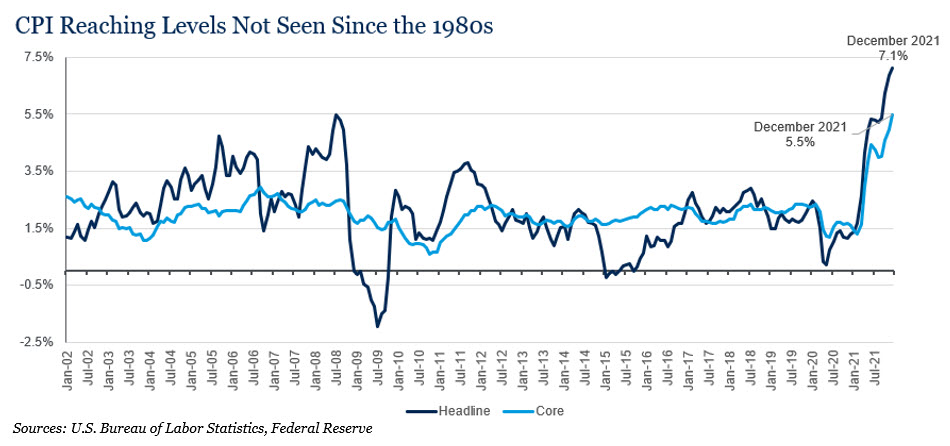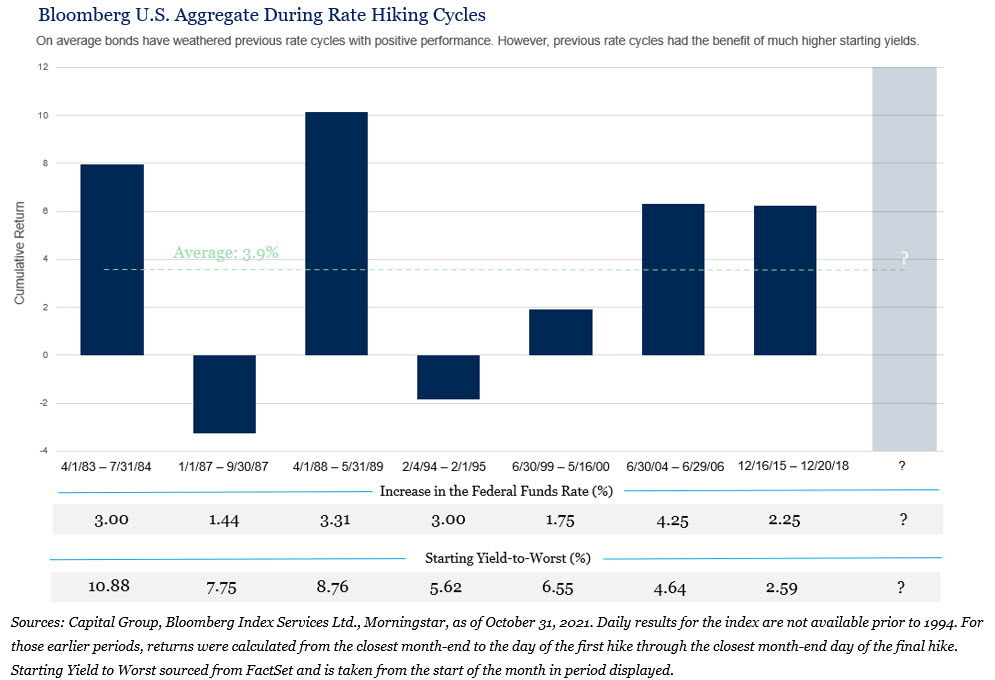Key Observations
• Many markets entered a technical correction (defined as a 10 percent pull back or more) in January as headline inflation reached levels not seen since the 1980s1 and the Federal Reserve continued to shift its stance, becoming less accommodative.
• It is worth noting the level and pace of the pullback year to date is typical. The median intra year draw down in the S&P 500 since 1980 is 9.3 percent.2
• Our 2022 Outlook – Navigating Moderation outlines our expectation for higher volatility and a focus on managing risk. See our outlook for additional details.
Market Recap
2022 started with a thud and plenty of market moving headlines. Omicron, inflation and the Federal Reserve, among other topics, weighed on the minds of investors. Most major indexes sold off with some crossing into a technical correction. Additionally, fixed income markets pulled back over the period as investors weighed new information from the Fed. Value stocks took a strong lead ahead of their growth counterparts to start the year. Such a pullback is not uncommon in equity markets. Since 1980, the median intra year draw down in the S&P 500 is 9.3 percent, yet the median annual return is 13.6 percent.

Inflation is on the minds of many investors, which came to the forefront as the Consumer Price Index (CPI) rose 7.1 percent over 2021, the strongest growth since the 1980s.3 The index was materially influenced by energy prices. Energy as a whole rose by nearly 30 percent and motor fuel was a primary contributor, up nearly 50 percent during the same time.4 In periods of rising inflation, capital intensive businesses with real (not accounting) assets on the balance sheet tend to perform better than businesses with intangible assets. The January pullback in intangible and technology-oriented companies fits this historical pattern as investors look to reconcile both higher valuations and rising inflation.


As a result of higher inflation, the Fed has been under pressure to stabilize prices. On January 26, the Federal Open Markets Committee (FOMC) announced they will hold interest rates at their current level (0 – 0.25 percent) but signaled it would “soon” look to increase rates to combat higher prices. Many Fed watchers interpret “soon” as March 2022. The Fed will continue to reduce its bond buying program and indicated it will seek to shrink its balance sheet (quantitative tightening, the opposite of quantitative easing better known as QE) only after it has begun to increase the Fed Funds rate. Fed Chair Jerome Powell noted “…I think there’s quite a bit of room to raise interest rates without threatening the labor market.”5
Fixed income investors took note of the Federal Reserve’s recent actions. As a result, interest rates moved higher during the month. The U.S. yield curve flattened as the U.S. 10-Year Treasury Yield ended the month at 1.79 percent, 27 basis points higher. Credit spreads widened in January as well, with investment grade and high yield credit spreads gaining 14 and 59 basis points, respectively. The higher move in interest rates, coupled with widening credit spreads, pushed bond prices lower. The broad fixed income market, as measured by the Bloomberg U.S. Aggregate Bond Index, returned -2.2 percent in January – the worst start to a calendar year since 1980.

Outlook
While the 20 trading days in January are a far cry from a full year, our 2022 Outlook – Navigating Moderation is certainly starting off on the right foot. Within our Outlook, we detail our view of volatility ahead, disparity in market outcomes, a focus on interest rate risk and a constructive view on emerging markets among other themes. We are focusing on those most front of mind for investors today.
Inflation – While CPI figures in January were eyebrow-raising and may persist longer than some would prefer we believe they are unsustainable. A combination of cooling in the red-hot energy market, easing shortages of semiconductors and used car prices and unkinking of the global supply chain can help moderate headline figures. Early signs of easing can be seen below in the ISM manufacturing data and the Baltic Dry Shipping Index, moderated from highs in 2021. With that said, we do not anticipate inflation dropping to the one to two percent range we have seen over the past two decades. We fully anticipate a more robust inflation environment in the coming years at three percent plus and believe portfolios should be positioned accordingly.

The Fed & Interest Rates – As depicted in the chart below, the Federal Reserve initiated seven cycles of rate increases since April 1983 and the average return of the Bloomberg U.S. Aggregate Index over those time periods was 3.9 percent. However, the average starting yield to worst (YTW) of the index across those periods was 6.7 percent. As of January 31, 2022, the Bloomberg Barclays Aggregate YTW was 2.1 percent.6
This indicates two things:
1. We believe the death of bonds is likely overstated. They can still play a critical role in portfolio diversification to control volatility.
2. Investors should consider their current exposures carefully. Extended interest rate risk, low current yields and less accommodative monetary policies may reveal risks that were previously nascent or perhaps unknown within fixed income.

For more information, please read our 2022 Outlook – Navigating Moderation, or reach out to any of the professionals at Fiducient Advisors.
1WSJ: Where Inflation Rose in 2021 in Seven Charts
2Fiducient Advisors – 2022 Outlook – Navigating Moderation
3WSJ: Where Inflation Rose in 2021 in Seven Charts
4U.S. Bureau of Labor Statistics
5Fortune
6FactSet, as of January 31, 2022
Indices cannot be invested in directly. Index performance is reported gross of fees and expenses and assumes the reinvestment of dividends and capital gains. Past performance does not indicate future performance and there is a possibility of a loss. See disclosure page for indices representing each asset class.
Comparisons to any indices referenced herein are for illustrative purposes only and are not meant to imply that actual returns or volatility will be similar to the indices. Indices cannot be invested in directly. Unmanaged index returns assume reinvestment of any and all distributions and do not reflect our fees or expenses.
• Consumer Price Index is a measure of prices paid by consumers for a market basket of consumer goods and services. The yearly (or monthly) growth rates represent the inflation rate.
• Bloomberg U.S. Aggregate Index covers the U.S. investment grade fixed rate bond market, with index components for government and corporate securities, mortgage pass-through securities, and asset-backed securities.
• The S&P 500 is a capitalization-weighted index designed to measure performance of the broad domestic economy through changes in the aggregate market value of 500 stocks representing all major industries.
• The NASDAQ is a broad-based capitalization-weighted index of stocks in all three NASDAQ tiers: Global Select, Global Market and Capital Market.
• Russell 1000 Growth measures the performance of those Russell 1000 companies with higher P/B ratios and higher forecasted growth values.
• Russell 1000 Value measures the performance of those Russell 1000 companies with lower P/B ratios and lower forecasted growth values.
• Russell 2000 consists of the 2,000 smallest U.S. companies in the Russell 3000 index.
• Russell 2000 Growth measures the performance of the Russell 2000 companies with higher P/B ratios and higher forecasted growth values.
• Russell 2000 Value measures the performance of those Russell 2000 companies with lower P/B ratios and lower forecasted growth values.
• MSCI EAFE is an equity index which captures large and mid-cap representation across Developed Markets countries around the world, excluding the U.S. and Canada. The index covers approximately 85% of the free float-adjusted market capitalization in each country.
• MSCI EAFE Value captures large and mid-cap securities exhibiting overall value style characteristics across Developed Markets countries around the world, excluding the U.S. and Canada. The value investment style characteristics for index construction are defined using three variables: book value to price, 12-month forward earnings to price and dividend yield. The index targets 50% coverage of the free float-adjusted market capitalization of the MSCI EAFE Index.
• MSCI EAFE Growth captures large and mid-cap securities exhibiting overall growth style characteristics across Developed Markets countries around the world, excluding the U.S. and Canada. The growth investment style characteristics for index construction are defined using five variables: long-term forward EPS growth rate, short-term forward EPS growth rate, current internal growth rate and long-term historical EPS growth trend and long-term historical sales per share growth trend. The index targets 50% coverage of the free float-adjusted market capitalization of the MSCI EAFE Index.
• MSCI Emerging Markets captures large and mid-cap representation across Emerging Markets countries. The index covers approximately 85% of the free-float adjusted market capitalization in each country.
• MSCI Emerging Markets Value captures large and mid-cap representation across Emerging Markets countries. The index covers approximately 85% of the free-float adjusted market capitalization in each country. The value investment style characteristics for index construction are defined using three variables: book value to price, 12-month forward earnings to price and dividend yield. The index targets 50% coverage of the free float-adjusted market capitalization of the MSCI Emerging Markets Index.
• MSCI Emerging Markets Growth captures large and mid-cap representation across Emerging Markets countries. The index covers approximately 85% of the free-float adjusted market capitalization in each country. The growth investment style characteristics for index construction are defined using five variables: long-term forward EPS growth rate, short-term forward EPS growth rate, current internal growth rate and long-term historical EPS growth trend and long-term historical sales per share growth trend. The index targets 50% coverage of the free float-adjusted market capitalization of the MSCI Emerging Markets Index.
• Institute for Supply Management (ISM) Manufacturing Purchasing Managers’ Index (PMI) is a monthly measure of US economic activity based on surveys from US manufacturing firms; it is a composite index with equal weights to sub-indexes, including new orders, production, employment, supplier delivers and inventories.
• Baltic Dry Shipping Index measures the cost to ship various dry raw materials used in manufacturing, such as coal, iron ore and grains, based on average prices paid for various shipping routes.
The information contained herein is confidential and the dissemination or distribution to any other person without the prior approval of Fiducient Advisors is strictly prohibited. Information has been obtained from sources believed to be reliable, though not independently verified. Any forecasts are hypothetical and represent future expectations and not actual return volatilities and correlations will differ from forecasts. This report does not represent a specific investment recommendation. The opinions and analysis expressed herein are based on Fiducient Advisor research and professional experience and are expressed as of the date of this report. Please consult with your advisor, attorney and accountant, as appropriate, regarding specific advice. Past performance does not indicate future performance and there is risk of loss.


